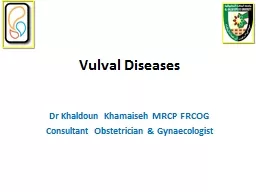PPT-IVASIVE DISEASE OF THE VULVA
Author : cecilia | Published Date : 2022-05-14
5 th class 20192020 Prof Dr Esraa Al maini Malignant tumor of the vulva are uncommon it represent about 4 of female genital malignancies It about three times
Presentation Embed Code
Download Presentation
Download Presentation The PPT/PDF document "IVASIVE DISEASE OF THE VULVA" is the property of its rightful owner. Permission is granted to download and print the materials on this website for personal, non-commercial use only, and to display it on your personal computer provided you do not modify the materials and that you retain all copyright notices contained in the materials. By downloading content from our website, you accept the terms of this agreement.
IVASIVE DISEASE OF THE VULVA: Transcript
Download Rules Of Document
"IVASIVE DISEASE OF THE VULVA"The content belongs to its owner. You may download and print it for personal use, without modification, and keep all copyright notices. By downloading, you agree to these terms.
Related Documents














